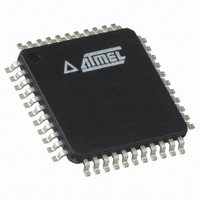ATMEGA8515-16AI Atmel, ATMEGA8515-16AI Datasheet - Page 78

ATMEGA8515-16AI
Manufacturer Part Number
ATMEGA8515-16AI
Description
IC AVR MCU 8K 16MHZ IND 44-TQFP
Manufacturer
Atmel
Series
AVR® ATmegar
Specifications of ATMEGA8515-16AI
Core Processor
AVR
Core Size
8-Bit
Speed
16MHz
Connectivity
EBI/EMI, SPI, UART/USART
Peripherals
Brown-out Detect/Reset, POR, PWM, WDT
Number Of I /o
35
Program Memory Size
8KB (4K x 16)
Program Memory Type
FLASH
Eeprom Size
512 x 8
Ram Size
512 x 8
Voltage - Supply (vcc/vdd)
4.5 V ~ 5.5 V
Oscillator Type
Internal
Operating Temperature
-40°C ~ 85°C
Package / Case
44-TQFP, 44-VQFP
Lead Free Status / RoHS Status
Contains lead / RoHS non-compliant
Data Converters
-
Available stocks
Company
Part Number
Manufacturer
Quantity
Price
Part Number:
ATMEGA8515-16AI
Manufacturer:
ATMEL/爱特梅尔
Quantity:
20 000
- Current page: 78 of 257
- Download datasheet (2Mb)
Extended MCU Control
Register – EMCUCR
General Interrupt Control
Register – GICR
78
ATmega8515(L)
The External Interrupt 0 is activated by the external pin INT0 if the SREG I-flag and the
corresponding interrupt mask are set. The level and edges on the external INT0 pin that
activate the interrupt are defined in Table 41. The value on the INT0 pin is sampled
before detecting edges. If edge or toggle interrupt is selected, pulses that last longer
than one clock period will generate an interrupt. Shorter pulses are not guaranteed to
generate an interrupt. If low level interrupt is selected, the low level must be held until
the completion of the currently executing instruction to generate an interrupt.
Table 41. Interrupt 0 Sense Control
• Bit 0 – ISC2: Interrupt Sense Control 2
The Asynchronous External Interrupt 2 is activated by the external pin INT2 if the SREG
I-bit and the corresponding interrupt mask in GICR are set. If ISC2 is written to zero, a
falling edge on INT2 activates the interrupt. If ISC2 is written to one, a rising edge on
INT2 activates the interrupt. Edges on INT2 are registered asynchronously. Pulses on
INT2 wider than the minimum pulse width given in Table 42 will generate an interrupt.
Shorter pulses are not guaranteed to generate an interrupt. When changing the ISC2
bit, an interrupt can occur. Therefore, it is recommended to first disable INT2 by clearing
its Interrupt Enable bit in the GICR Register. Then, the ISC2 bit can be changed. Finally,
the INT2 Interrupt Flag should be cleared by writing a logical one to its Interrupt Flag bit
(INTF2) in the GIFR Register before the interrupt is re-enabled.
Table 42. Asynchronous External Interrupt Characteristics
• Bit 7 – INT1: External Interrupt Request 1 Enable
When the INT1 bit is set (one) and the I-bit in the Status Register (SREG) is set (one),
the external pin interrupt is enabled. The Interrupt Sense Control1 bits 1/0 (ISC11 and
ISC10) in the MCU General Control Register (MCUCR) define whether the External
Interrupt is activated on rising and/or falling edge of the INT1 pin or level sensed. Activity
on the pin will cause an interrupt request even if INT1 is configured as an output. The
Bit
Read/Write
Initial Value
Bit
Read/Write
Initial Value
Symbol
ISC01
t
INT
0
0
1
1
Parameter
Minimum pulse width for
asynchronous external interrupt
ISC00
0
1
0
1
SM0
R/W
INT1
R/W
7
0
7
0
Description
The low level of INT0 generates an interrupt request.
Any logical change on INT0 generates an interrupt request.
The falling edge of INT0 generates an interrupt request.
The rising edge of INT0 generates an interrupt request.
SRL2
R/W
INT0
R/W
6
0
6
0
SRL1
R/W
INT2
R/W
5
0
5
0
SRL0
R/W
4
0
R
4
–
0
SRW01
R/W
Condition
3
0
R
3
–
0
SRW00
R/W
2
0
R
2
–
0
Min
SRW11
IVSEL
R/W
R/W
1
0
1
0
Typ
50
ISC2
R/W
IVCE
R/W
0
0
0
0
2512K–AVR–01/10
Max
EMCUCR
GICR
Units
ns
Related parts for ATMEGA8515-16AI
Image
Part Number
Description
Manufacturer
Datasheet
Request
R

Part Number:
Description:
IC AVR MCU 2.4GHZ XCEIVER 64QFN
Manufacturer:
Atmel
Datasheet:

Part Number:
Description:
Manufacturer:
Atmel
Datasheet:

Part Number:
Description:
MCU ATMEGA644/AT86RF230 40-DIP
Manufacturer:
Atmel
Datasheet:

Part Number:
Description:
BUNDLE ATMEGA644P/AT86RF230 QFN
Manufacturer:
Atmel
Datasheet:

Part Number:
Description:
BUNDLE ATMEGA644P/AT86RF230 TQFP
Manufacturer:
Atmel
Datasheet:

Part Number:
Description:
MCU ATMEGA1281/AT86RF230 64-TQFP
Manufacturer:
Atmel
Datasheet:

Part Number:
Description:
MCU ATMEGA1280/AT86RF230 100TQFP
Manufacturer:
Atmel
Datasheet:

Part Number:
Description:
BUNDLE ATMEGA1280/AT86RF100-TQFP
Manufacturer:
Atmel
Datasheet:

Part Number:
Description:
BUNDLE ATMEGA2560V/AT86RF230-ZU
Manufacturer:
Atmel
Datasheet:

Part Number:
Description:
MCU ATMEGA2561/AT86RF230 64-TQFP
Manufacturer:
Atmel
Datasheet:

Part Number:
Description:
INTERVAL AND WIPE/WASH WIPER CONTROL IC WITH DELAY
Manufacturer:
ATMEL Corporation
Datasheet:

Part Number:
Description:
Low-Voltage Voice-Switched IC for Hands-Free Operation
Manufacturer:
ATMEL Corporation
Datasheet:

Part Number:
Description:
MONOLITHIC INTEGRATED FEATUREPHONE CIRCUIT
Manufacturer:
ATMEL Corporation
Datasheet:

Part Number:
Description:
AM-FM Receiver IC U4255BM-M
Manufacturer:
ATMEL Corporation
Datasheet:











